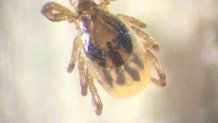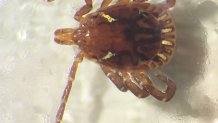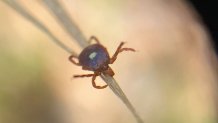As heat in the summer rises, people start to ramp up outdoor activities — making them prone to tick bites. During this season, some ticks are in their most dangerous life stage, and they are able to hide undetected on clothes and pets.
Alex Cumbie, a postdoctoral researcher at Virginia Tech Assistant Professor Gillian Eastwood's disease ecology lab, says it is still too early to know if this is a more aggressive tick season than previous years, but so far she is seeing more ticks than usual.
"Right now, it kind of feels like we're super inundated with ticks," Cumbie says. "I'm like covered in ticks when I'm collecting."
It also takes a couple of months for people to report symptoms of diseases, like Lyme disease, after they are bit by a tick.
We're making it easier for you to find stories that matter with our new newsletter — The 4Front. Sign up here and get news that is important for you to your inbox.
This is how you can protect yourself from ticks this summer.
Keep an eye out for these ticks in D.C., Virginia and Maryland
People should be on alert for deer ticks, also known as the blacklegged ticks.
This tick feeds in the spring and summer during the "nymph" life stage. The Centers for Disease Control and Prevention terms this stage as the most dangerous because people can't spot its body, which is less than 2 millimeters in size. When out, look out for this black tick the size of a poppy seed.

Also prevalent in the region are Lone Star ticks. "Reddish brown" in color, Cumbie says these ticks move fast and are known to be found wherever deer are present.

Deer ticks thrive in high-elevated areas, while Lone Star ticks are more common in areas with low elevation, like coastal Virginia.
Local
Washington, D.C., Maryland and Virginia local news, events and information
What diseases do these ticks carry?
The deer ticks can spread Lyme disease and babesia.
"And people wouldn't even know it because the tick is the size of a poppy seed on their ankle," Cumbie says.
Lone Star ticks are responsible for spreading the red meat allergy alpha-gal syndrome. The CDC says the tick bite can lead to a "serious, potentially life-threatening allergic reaction" to meats.
So you found a tick on you — what should you do?
Keep the tick and send it to a local university or a group that test ticks for pathogens.
Look out for symptoms that feel like you have a summer flu, or achy muscles, as most symptoms of tick-borne diseases present as flu-like symptoms. A lot of people also experience joint pain, nausea, diarrhea or headaches.
For Lyme disease, also look out for a bull's eye rash. If symptoms appear, Cumbie advises you go to the doctor immediately because you don't want the infection to fester.
If you decide to go to the doctor before showing any symptoms, doctors may prescribe preventive antibiotics.
After you return from a tick habitat, Cumbie also recommends throwing your clothes in the dryer on high for at least 15 minutes before washing them. Cumbie says that should kill all the ticks because what ticks need is moisture.
Places to avoid
Avoid areas that have animals such as deer, rabbits or groundhogs. Those areas will probably have ticks because of the presence of animals.
Most ticks are found on the edges of habitats — where the forest meets the field, for example. If you are in the middle of a well-groomed field, you probably aren't going to get ticks on you, but be aware that animals may carry them.

When hiking, don't wander into the forest. Instead, stay on the trail, a dirt path or on gravel, as ticks don't like dry areas. Make sure your pets also stay on trails and don't wander out into the forest.
If you are having a picnic, avoid having it near tall grass. In these situations, ticks like the Lone Star, can crawl towards you.
How to keep your pets safe
Talk to your veterinarian about special collars, oral or topical medications for your dogs.
Before your pets go inside your house, check their belly, ears and groin area for ticks. Once you do that, clean the area where the ticks were found. Animals can have the same skin reaction to ticks as humans.
Keep any of the ticks you pull out and get them tested for pathogens if you can.
What to wear to prevent tick bites
When going out, wear-light colored clothing so it will be easy to spot ticks on you.
Cumbie also recommends treating clothes with the insect repellent permethrin. To apply it safely, spray it when it's dry, away from people, and make sure you don't breathe in the permethrin.
If you don't feel comfortable treating clothes yourself, Cumbie recommends buying bandanas for dogs, blankets, shirts or socks that are already treated with permethrin.
"If they encounter your socks that are treated with this stuff first, they're going to die before they even make it on your body to feed," Cumbie says.
Always have someone check your back when returning from outdoor activities. Other places to check for ticks are the armpits, behind your knees and groin area.



